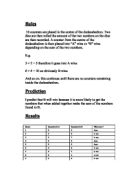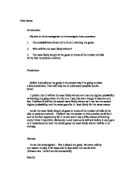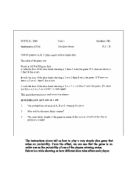L
L
L #
W – Wins
L – Loses
At # the diagram then starts again at * and follows this pattern continuously except the final probabilities will be different.
Next I wrote down in a table the probabilities of A, B and C winning on their first, second, third and fourth attempts. Multiplying down through the probability tree’s branches did this.
From this I noted that these could probably be greatly simplified so I did and from this I noticed that you could easily make As attempts with the same denominator on the bottom of the fraction as the others so I added another row to the table.
I then noticed some patterns emerging, such as:
P(B winning) = P(C winning).
I also noticed that 182 is 324, 183 is 5832 and 184 is 104976.
And 52 is 25, 53 is 125 and 54 is 625.
If n represents on which attempt they win on I can work out with the nth term that:
P(B Winning) = P( C winning) = (5/18)n
(5/18)1 = 5/18
(5/18)2 = 25/324
(5/18)3 = 125/5832
(5/18)4 = 625/104976
I then tested to see if A ∝ (B = C) in a similar pattern between each attempt.
Attempt 1
A = K(B = C).
(3/18) = (5/18)K.
Therefore: K= 3/5.
Attempt 2
A = K(B = C).
(15/324) = (25/324)K.
Therefore: K = 3/5.
Attempt 3
A = K(B = C).
(75/5832) = (125/5832)K.
Therefore: K = 3/5.
Attempt 4
A = K(B = C).
(375/104976) = (625/104976)K.
Therefore. K = 3/5.
That means that A is always directly proportional to B and C at the same proportion for throughout each attempt.
The probability of A winning is 3/5 of the probability of B winning and 3/5 of the probability of C winning.
So using the nth term I can determine that:
P(A winning) = 3/5.{(5/18)n}
P(B winning) = (5/18)n
P(C winning) = (5/18)n
This means if the final probabilities for each person winning were in a fraction and were over the same denominator B and C would have the same multiple (They would be equal) and C’s multiple would be 3/5 of their top multiples. So if B’s and C’s multiple was 5, A’s multiple would be 3.
ie. P(A winning) = 3/x
P(B winning) = 5/x
P(C winning) = 5/x
So for this to make sense we know they must add up to one.
P(A winning) + P(B winning) + P(C winning) = x/x
3/x + 5/x + 5/x =x/x
*x) x = 3 + 5 + 5
x = 13
Therefore: P(A winning) = 3/13
P(B winning) = 5/13
P(C winning) = 5/13
The next question was to know how many goes should it be before someone wins. For this I set up a chart to see what was the probability of someone winning or not winning in each round. P(winning) was worked out by adding the three probabilities of each person together. P(not winning) was worked out by taking this number from one.
From this I can conclude you that the most likely attempt to win in is attempt 1 with (13/18). From on the probability of someone winning is multiplied by (5/18) each time. Then the most likely person to win is either A or B as they have the highest chances of winning with both having (5/18) in attempt one.
Therefore the game is most likely to be won by Bs or Cs first attempts.
We were told that this problem could be worked out in just a few lines. The quickest I could find was by writing down the probability of each person winning in the first round with the same denominator.
We can work out that the probability of each person winning in each round will be directly proportion to the other people in their round. For example as shown we knew that ‘B = C and 3/5(B or C) = A’ through all different rounds. This is because the probability tree is entirely repetitive, as you multiply the same probabilities again and again down the branches, therefore the proportion between probabilities in each round is at a constant. This being 3/5 or 5/3 however you look at it.
From this we now only need to work out attempt 1s probabilities and to simply work out any other different types of scenario just change the denominator so it adds up to one when you add all the players changes together.
From this I can get:
P(A winning) = 3/13.
P(B winning) = 5/13.
P(C winning) = 5/13.
This probability investigation is entirely dependant on what position you go in. If for example C went first, then B second and A third.
As shown from this we can see that in both attempts.
C is three times more likely to win than B.
And B is three times more likely to win than A.
We can work out using my early-described method:
P(A winning) = 1/13
P(B winning) = 3/13
P(C winning) = 9/13
So I can conclude that there is a set way to work out these problems as I have explained. You may also work out what the LCD is for these probability by making the total equal 1.







